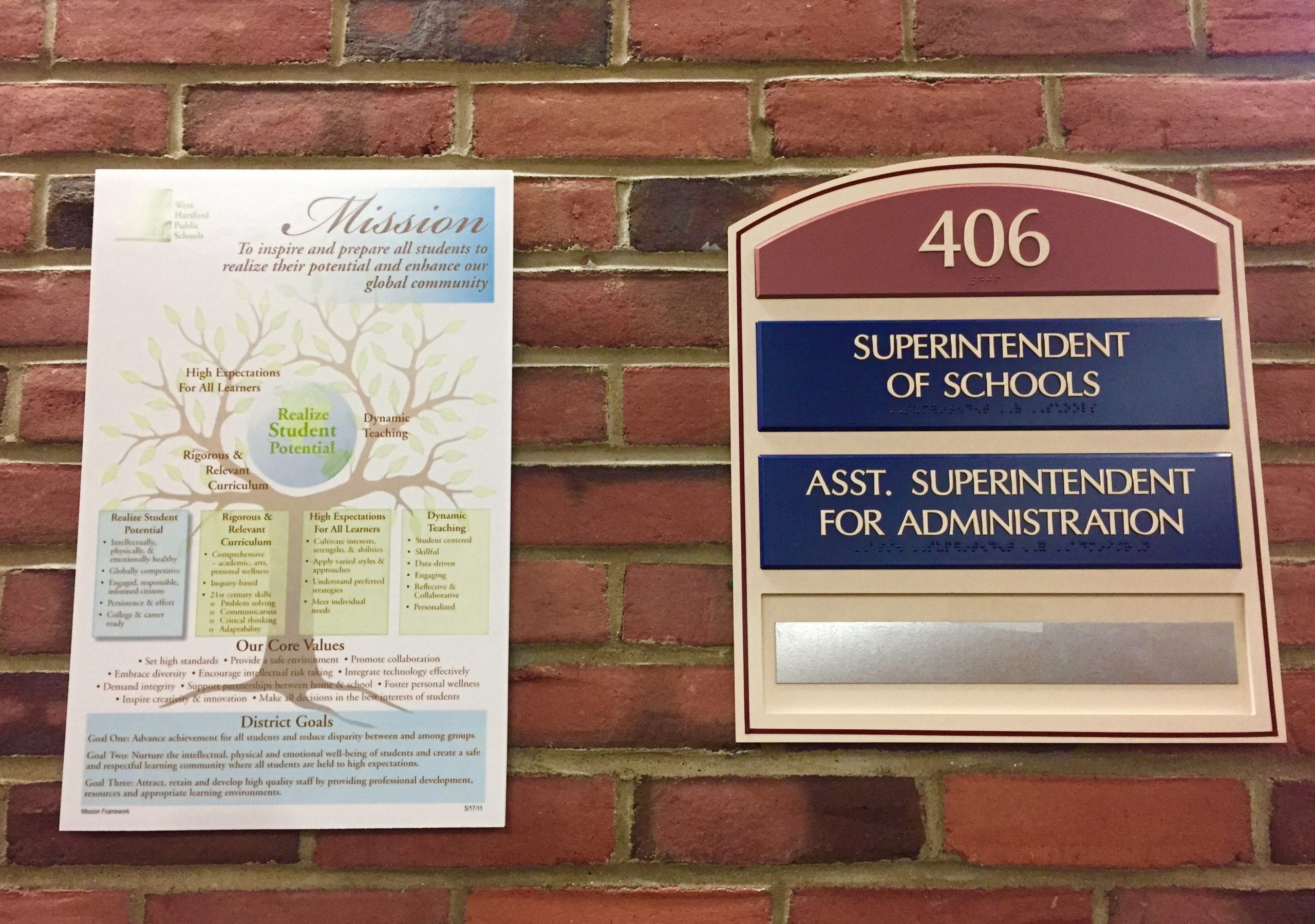Board of Education Begins Budget Process with Review of Capital Improvement Plan, Enrollment Projections

Audio By Carbonatix

West Hartford Public Schools Superintendent's Office. Photo credit: Ronni Newton (we-ha.com file photo)
The West Hartford Board of Education received the Capital Improvement Plan at Tuesday night’s meeting, and also heard a presentation on enrollment.
By Ronni Newton
Superintendent of Schools Tom Moore kicked off the official discussion of the West Hartford Public Schools’ next fiscal year budget with the presentation of the Capital Improvement Plan on Tuesday night, and the Board of Education also received an update on enrollment projections as part of the budgeting process.
“The CIP really lists our priorities for the school buildings,” Moore said. While many times the CIP spending isn’t obvious, because it’s an investment in masonry or new flooring, “I think with coronavirus and the impact and the interest in our ventilation systems it’s certainly taken on a greater priority,” he said.
Last year, the Board of Education passed a $7,740,000 CIP, and after the Town Council, during its overall budget adoption process, cut $100,000, the Board moved forward with a $7,640,000 plan for FY 2021-21.
The proposal for FY 2021-22 is $6,734,000 – a smaller number than in the previous year because most of the work enhancing school security has already been completed.
While a 12-year plan is submitted, only two years of the plan are approved each year by the board. The planned expenditure for 2022-23 is $8,228,000. Elementary school air quality improvements will begin in FY 2022-23, and will add another $2,500,000 to the CIP in the first year of that project, with the estimated costs increasing slightly each year.
“One of the things – that is really the most important thing we’ve been doing in the past five years – is reworking all of our schools entryways to provide security,” Andy Morrow, assistant superintendent for administration, told the Board Tuesday night. The reconfigured entryways provide two sets of doors – known as a mantrap. In some cases the security project has also required relocation or reconfiguration of the schools’ main offices.
Some work, including main entrance security upgrades at Whiting Lane and Wolcott, was postponed from last summer to the summer of 2021.
Other projects that were postponed and are now planned for the summer of 2021 include replacement of Hall High School’s culinary arts kitchen and roof, replacement of the roof at Sedgwick Middle School, and new visitor bleachers at Conard High School, Director of Plant and Facilities Bob Palmer said.
Palmer also said that the district had originally prepared to replace entire steam boiler system at King Philip Middle School, but the bids came back too high. The main cost driver was replacing piping, and instead some modifications will be made to keep the steam boiler in place. He said that should provide another 10 years of service, and the rest of the funds that were intended to be used will instead go toward replacing the auditorium’s air handler.
The reason some of the projects were postponed last summer, Palmer said, was that the “supply chain and the manufacturing process were substantially interrupted,” not only by COVID-19 but also by natural disasters. He expects to continue to have some supply problems this summer as well, particularly with specialty items.
The good thing about postponing the roofing projects, however, is that those costs have dropped and the projects bids are coming in below budget.
Morrow said that as part of the plan for reopening schools for this academic year amid the COVID-19 pandemic, districts were encouraged to do HVAC assessments. The assessment cost roughly $250,000. “The benefit of that is that it really gave us a solid understanding of our systems,” he said.
While both high schools and all three middle schools are air conditioned, only two of the town’s elementary schools have air conditioning. Those schools, many of which were built in the 1950s, also have outdated air circulation systems and inefficient single-pane windows.
Seven of the 11 elementary schools have no fresh air handling systems, Palmer said.
Duffy Elementary School, which is two stories and includes the original windows and ventilation system dating back to its construction in the 1950s, will be the first to receive the upgrades, which will be made over the course of two summers.
The CIP will be adopted at the Board of Education’s Feb. 2 meeting. Tuesday’s presentation can be found as a PDF below.
Chip Ward, who retired from West Hartford Public Schools as the director of finance and planning several years ago, was once again engaged to provide enrollment projections that he details to the Board on Tuesday night.
Looking at birth trends and the “cohort survival ratio,” Ward is continuing to project a decline in overall enrollment.
As of Oct. 1, 2020, West Hartford Public Schools had 8,876 students enrolled in grades kindergarten through 12. He is estimating 8,675 students as of Oct. 1, 2021, a decline of 201.
Ward is projecting overall enrollment to gradually drop to 7,505 over the course of the next 10 years, with an average decrease of 132 students per year based on “decline in the number births in West Hartford since 2001 and the declining trend statewide in K-12 enrollments.”
Declining enrollment has been currently impacting the elementary schools, but will be moving to the middle schools and then the high schools. Over the next six years, Ward said, middle school enrollment at all three schools combined is expected to decline from the current 2,087 to 1,772, and enrollment in the high schools, currently at 2,946, is expected to drop to 2,424 by 2026-27.
The cohort survival ratio accounts for families moving to West Hartford to attend school, deciding to go to private or parochial school, moving due to economic reason, and a natural turnover of 500-800 homes per year, Ward said.
“It doesn’t account for COVID-19,” Ward said. This year, the district had 200 fewer students than expected, spread pretty much evenly across schools and grade levels. No explanation has been found and no one has been able to determine where those “lost kids” have gone, and the district is not sure whether or not it’s a “one-time blip” or a permanent decrease.
Board member Liz Wilcox asked Ward if he foresees a time when the district won’t need all 11 elementary schools. “That is a Board question .. and a policy decision,” he said.
Moore said it doesn’t save as much as people think to close schools unless the buildings are sold, because the number of teachers is dependent on the number of students in each section, not the physical plant.
“We’ve cut 32 classrooms” in response to declining enrollment, Moore said, which is technically like closing an elementary school.
Ward’s presentation can be found as a PDF below.
Like what you see here? Click here to subscribe to We-Ha’s newsletter so you’ll always be in the know about what’s happening in West Hartford! Click the blue button below to become a supporter of We-Ha.com and our efforts to continue producing quality journalism.
